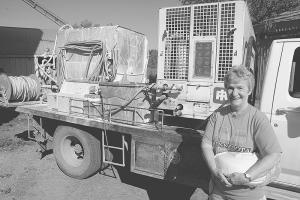2007 - Volume #31, Issue #1, Page #09
[ Sample Stories From This Issue | List of All Stories In This Issue | Print this story
| Read this issue]
Demand Strong For Barn Whitewashing
 |
In fact, Phyllis has worked in this trade for 23 years in all û 10 years for another operator, and then another 13 years when she and her husband started their business, "Gibbs Whitewashing".
From April until November each year, the couple travels around Minnesota and into S. Dakota, whitewashing the interiors of 400 barns per year, on average. The majority are dairy barns, with some hog and chickens barns mixed in, and fall is always the busiest season.
Their mobile business consists of a 1-ton flatbed truck, equipped with an air compressor (118 lbs. of pressure), an 85-gal. tank to mix the whitewash, a pump to spray it out, 250 ft. of hose on each unit, a long-handled metal scraper, and tool boxes.
Phyllis starts cleaning the barns by blowing the dust and cobwebs out, using the air compressor and the hose with a 6-ft. copper tubing wand at the end.
"It's a very dirty job, so I wear a special helmet with a clear plastic face mask and a motor on the back of it to supply clean air," she says. "It keeps the dust and whitewash chips out of my face, but at times, it's very hot to wear. While I blow, Tony scrapes manure off the posts and walls."
On some barns with metal sheeting, the Athmanns do some power washing. (Whitewash is only applied to wood surfaces.) Most of their customers hire them every year or every other year, since regular maintenance is necessary to keep barns sanitary and satisfy inspectors.
The couple get up at 5 a.m. to start their day. Although the majority of jobs are close enough that they can go home at night, the couple also travels up to a couple of hundred miles away, staying in hotels.
"We clean barns at least nine hours a day, and schedule our next jobs in the evening when we get back. In the fall, we leave in the dark and come home in the dark."
Before Phyllis can begin blowing a barn, they have to cover the cow's drinking cups. While she runs the air compressor, Tony covers fuse boxes, windows, light switches, the milk pipeline, and anything else that shouldn't be sprayed.
"We have fun and laugh a lot. I grew up on a dairy farm so I love the fact that I'm out in the country," Phyllis says. "Farmers are really nice. I've always said we work for the best people there are to work for."
Whitewash is a white, clay powder that comes from mines in West Virginia. It's a less expensive, shorter lasting and more natural way than paint to make barn interiors white. It comes in 50-lb. bags, each of which is mixed with 16 gal. of water.
"We charge customers seven cents per square foot for local jobs," she explains.
The Athmanns retired and sold their business a few months ago to Nick Meyer. It's now called Meyer Whitewashing.
Contact: FARM SHOW Followup, Phyllis and Tony Athmann, 35555 County Rd. 26, Sauk Centre, Minn. 56378 (ph 320 352-3159; tpathmann@mainstreetcom.com).

Click here to download page story appeared in.

Click here to read entire issue
To read the rest of this story, download this issue below or click here to register with your account number.




